|
|
---
|
|
|
|
|
|
Tag: ["🎭", "🎶", "🎤", "🇺🇸", "👤", "🗞️"]
|
|
|
Date: 2023-12-10
|
|
|
DocType: "WebClipping"
|
|
|
Hierarchy:
|
|
|
TimeStamp: 2023-12-10
|
|
|
Link: https://time.com/6342806/person-of-the-year-2023-taylor-swift/
|
|
|
location:
|
|
|
CollapseMetaTable: true
|
|
|
|
|
|
---
|
|
|
|
|
|
Parent:: [[@News|News]]
|
|
|
Read:: [[2023-12-20]]
|
|
|
|
|
|
---
|
|
|
|
|
|
 
|
|
|
|
|
|
```button
|
|
|
name Save
|
|
|
type command
|
|
|
action Save current file
|
|
|
id Save
|
|
|
```
|
|
|
^button-TaylorSwiftIsTIMEs2023PersonoftheYearNSave
|
|
|
|
|
|
 
|
|
|
|
|
|
# Taylor Swift Is TIME's 2023 Person of the Year
|
|
|
|
|
|
Taylor Swift is telling me a story, and when [Taylor Swift](https://time.com/collection/100-most-influential-people-2019/5567666/taylor-swift/) tells you a story, you listen, because you know it’s going to be good—not only because she’s had an extraordinary life, but because she’s an extraordinary storyteller. This one is about a time she got her heart broken, although not in the way you might expect.
|
|
|
|
|
|
She was 17, she says, and she had booked the biggest opportunity of her life so far—a highly coveted slot opening for country superstar Kenny Chesney on tour. “This was going to change my career,” she remembers. “I was so excited.” But a couple weeks later, Swift arrived home to find her mother Andrea sitting on the front steps of their house. “She was weeping,” Swift says. “Her head was in her hands as if there had been a family emergency.” Through sobs, Andrea told her daughter that Chesney’s tour had been sponsored by a beer company. Taylor was too young to join. “I was devastated,” Swift says.
|
|
|
|
|
|
But some months later, at Swift’s 18th birthday party, she saw Chesney’s promoter. He handed her a card from Chesney that read, as Swift recalls, “I’m sorry that you couldn’t come on the tour, so I wanted to make it up to you.” With the note was a check. “It was for more money than I’d ever seen in my life,” Swift says. “I was able to pay my band bonuses. I was able to pay for my tour buses. I was able to fuel my dreams.”
|
|
|
|
|
|

|
|
|
|
|
|
Photograph by Inez and Vinoodh for TIME
|
|
|
|
|
|
Listening to Swift share this, on a clear fall afternoon in her New York City apartment, I’m struck by how satisfying the story is. There are high stakes at the outset; there are details, vivid and sensory; there’s a twist that flips the action on its head; and there’s a happy ending for its hero. It takes her only about 30 seconds to recount this, but those 30 seconds contain an entire narrative world.
|
|
|
|
|
|
I’m not surprised. Swift has a preternatural skill for finding the story. Her anecdote about Chesney symbolizes a larger narrative in Swift’s life, one about redemption—where our protagonist discovers new happiness not despite challenges, but because of them. Swift, as we’ll discuss, took a few hits to get here. “I’ve been raised up and down the flagpole of public opinion so many times in the last 20 years,” she says as we tuck into a cozy den off the kitchen to talk, and she kicks off her shoes and curls up onto the sofa. “I’ve been given a tiara, then had it taken away.” She is seemingly unguarded in conversation, reflective about both where she’s been and where she finds herself now. After all, while she’s long been one of the biggest entertainers in the world, this year is different. “It feels like the breakthrough moment of my career, happening at 33,” she says. “And for the first time in my life, I was mentally tough enough to take what comes with that.” This is her story—even if she’s now so high that it’s hard to believe she was ever low.
|
|
|
|
|
|

|
|
|
|
|
|
Photograph by Inez and Vinoodh for TIME
|
|
|
|
|
|
Swift’s accomplishments as an artist—culturally, critically, and commercially—are so legion that to recount them seems almost beside the point. As a pop star, she sits in rarefied company, alongside Elvis Presley, Michael Jackson, and Madonna; as a songwriter, she has been compared to Bob Dylan, Paul McCartney, and Joni Mitchell. As a businesswoman, she has built an empire worth, by some estimates, over $1 billion. And as a celebrity—who by dint of being a woman is scrutinized for everything from whom she dates to what she wears—she has long commanded constant attention and knows how to use it. (“I don’t give Taylor advice about being famous,” Stevie Nicks tells me. “She doesn’t need it.”) But this year, something shifted. To discuss her movements felt like discussing politics or the weather—a language spoken so widely it needed no context. She became the main character of the world.
|
|
|
|
|
|
If you’re skeptical, consider it: How many conversations did you have about Taylor Swift this year? How many times did you see a photo of her while scrolling on your phone? Were you one of the people who made a pilgrimage to a city where she played? Did you buy a ticket to her concert film? Did you double-tap an Instagram post, or laugh at a tweet, or click on a headline about her? Did you find yourself humming “[Cruel Summer](https://time.com/6287902/cruel-summer-taylor-swift-single/)” while waiting in line at the grocery store? Did a friend confess that they watched clips of the [Eras Tour](https://time.com/6341858/taylor-swift-eras-tour-movie-streaming/) night after night on TikTok? Or did you?
|
|
|
|
|
|
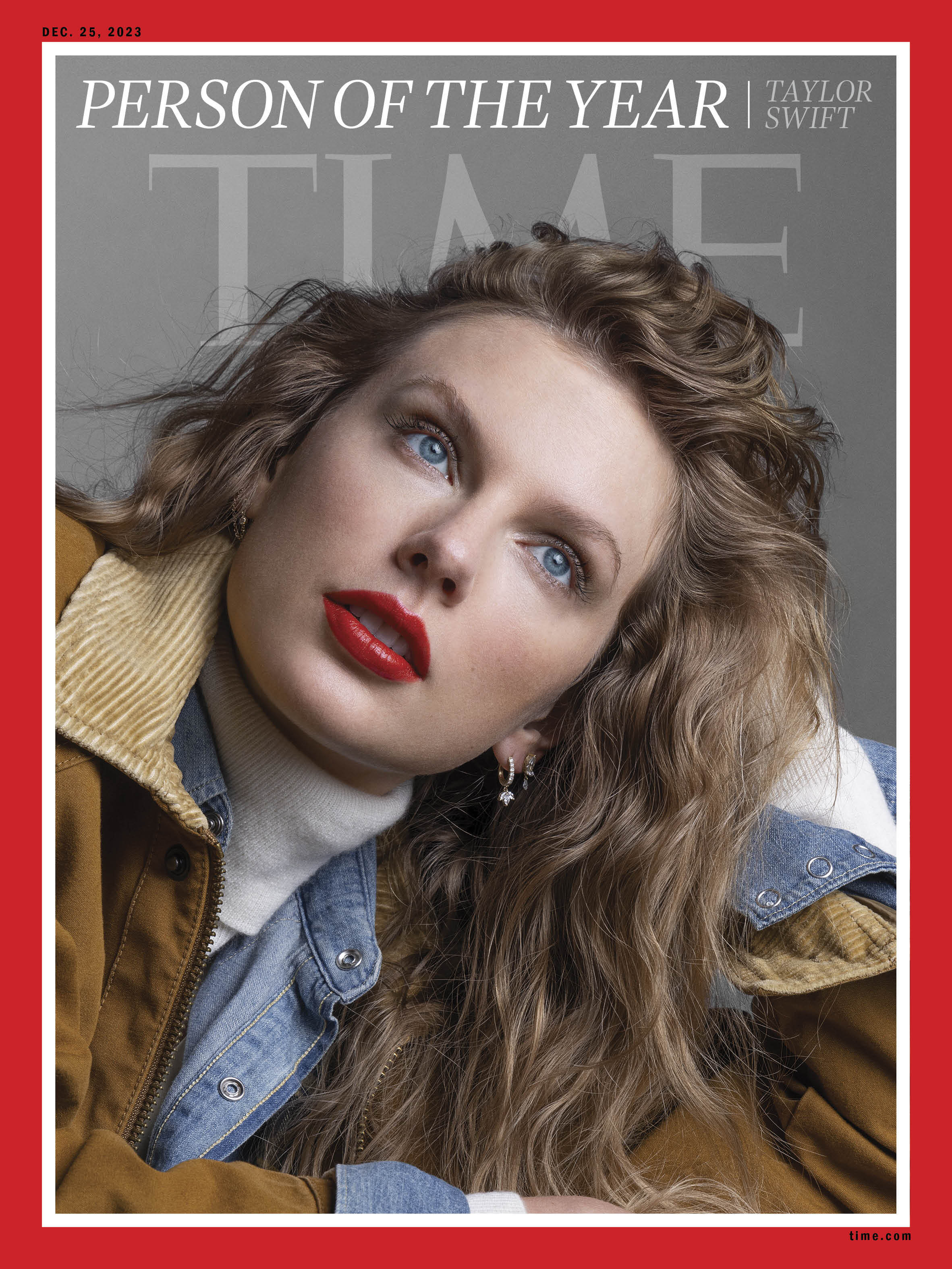
|
|
|
|
|
|
Photograph by Inez and Vinoodh for TIME
|
|
|
|
|
|
Her epic career-retrospective tour recounting her artistic “eras,” which played 66 dates across the Americas this year, is projected to become the biggest of all time and the first to gross over a billion dollars; analysts talked about the “Taylor effect,” as politicians from Thailand, Hungary, and Chile implored her to play their countries. Cities, stadiums, and streets were renamed for her. Every time she came to a new place, a mini economic boom took place as hotels and restaurants saw a surge of visitors. In [releasing her concert movie](https://time.com/6323858/taylor-swift-the-eras-tour-movie-review/), Swift bypassed studios and streamers, instead forging an unusual pact with AMC, giving the theater chain its highest single-day ticket sales in history. There are at least 10 college classes devoted to her, including one at Harvard; the professor, Stephanie Burt, tells TIME she plans to compare Swift’s work to that of the poet William Wordsworth. Friendship bracelets traded by her fans at concerts became a hot accessory, with one line in a song causing as much as a 500% increase in sales at craft stores. When Swift started dating Travis Kelce, the Kansas City Chief and two-time Super Bowl champion, his games saw a massive increase in viewership. (Yes, she somehow made one of America’s most popular things—football—even more popular.) And then there’s her critically hailed songbook—a catalog so beloved that as [she rereleases it](https://time.com/5949979/why-taylor-swift-is-rerecording-old-albums/), she’s often breaking chart records she herself set. She’s the last monoculture left in our stratified world.
|
|
|
|
|
|
It’s hard to see history when you’re in the middle of it, harder still to distinguish Swift’s impact on the culture from her celebrity, which emits so much light it can be blinding. But something unusual is happening with Swift, without a contemporary precedent. She deploys the most efficient medium of the day—the pop song—to tell her story. Yet over time, she has harnessed the power of the media, both traditional and new, to create something wholly unique—a narrative world, in which her music is just one piece in an interactive, shape-shifting story. Swift is that story’s architect and hero, protagonist and narrator.
|
|
|
|
|
|
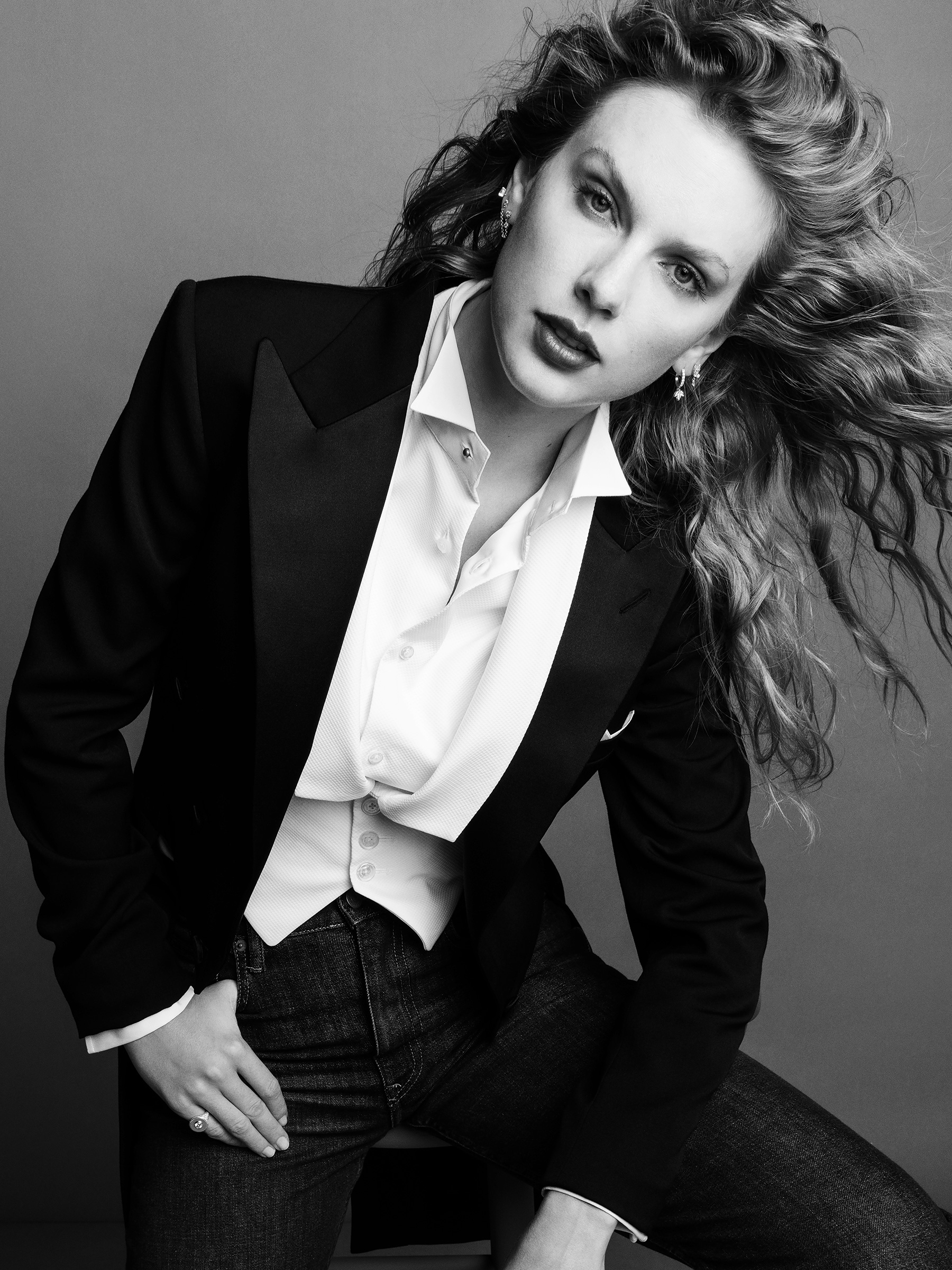
|
|
|
|
|
|
Inez and Vinoodh for TIME
|
|
|
|
|
|
This was the year she perfected her craft—not just with her music, but in her position as the master storyteller of the modern era. The world, in turn, watched, clicked, cried, danced, sang along, swooned, caravanned to stadiums and movie theaters, let her work soundtrack their lives. For Swift, it’s a peak. “This is the proudest and happiest I’ve ever felt, and the most creatively fulfilled and free I’ve ever been,” Swift tells me. “Ultimately, we can convolute it all we want, or try to overcomplicate it, but there’s only one question.” Here, she adopts a booming voice. *“Are you not entertained?”*
|
|
|
|
|
|
---
|
|
|
|
|
|
**A few months before** I sit with Swift in New York, on a summer night in Santa Clara, Calif., which has been temporarily renamed Swiftie Clara in her honor, I am in a stadium with nearly 70,000 other people having a religious experience. The crowd is rapturous and Swift beatific as she gazes out at us, all high on the same drug. Her fans are singularly passionate, not just in the venue but also online, as they analyze clues, hints, and secret messages in everything from her choreography to her costumes—some deliberately planted, others not. (“Taylor Swift fans are the modern-day equivalent of those cults who would consistently have inaccurate rapture predictions like once a month,” [as one viral tweet noted](https://twitter.com/Coll3enG/status/1582520477175533568).)
|
|
|
|
|
|
[*Subscribe now and get the Person of the Year issue*](http://time.com/subscribe)
|
|
|
|
|
|
Standing in the arena, it’s not hard to understand why this is the biggest thing in the world. “Beatlemania and *Thriller* have nothing on these shows,” says Swift’s friend and collaborator Phoebe Bridgers. Fans in Argentina pitched tents outside the venue for months to get prime spots, with some quitting their jobs to commit to fandom full time. Across the U.S., others lined up for days, while those who didn’t get in “Taylor-gated” in nearby parking lots so they could pick up the sound. When tickets went on sale last year, Ticketmaster crashed. Although 4.1 million tickets were sold for the 2023 shows—including over 2 million on the first day, a new record—scalpers jacked up prices on the secondary market to more than $22,000. Multiple fans filed lawsuits. The Justice Department moved forward with an investigation. The [Senate held a hearing](https://time.com/6249730/ticketmaster-taylor-swift-hearing-congress/). Given these stakes, Swift had to deliver.
|
|
|
|
|
|
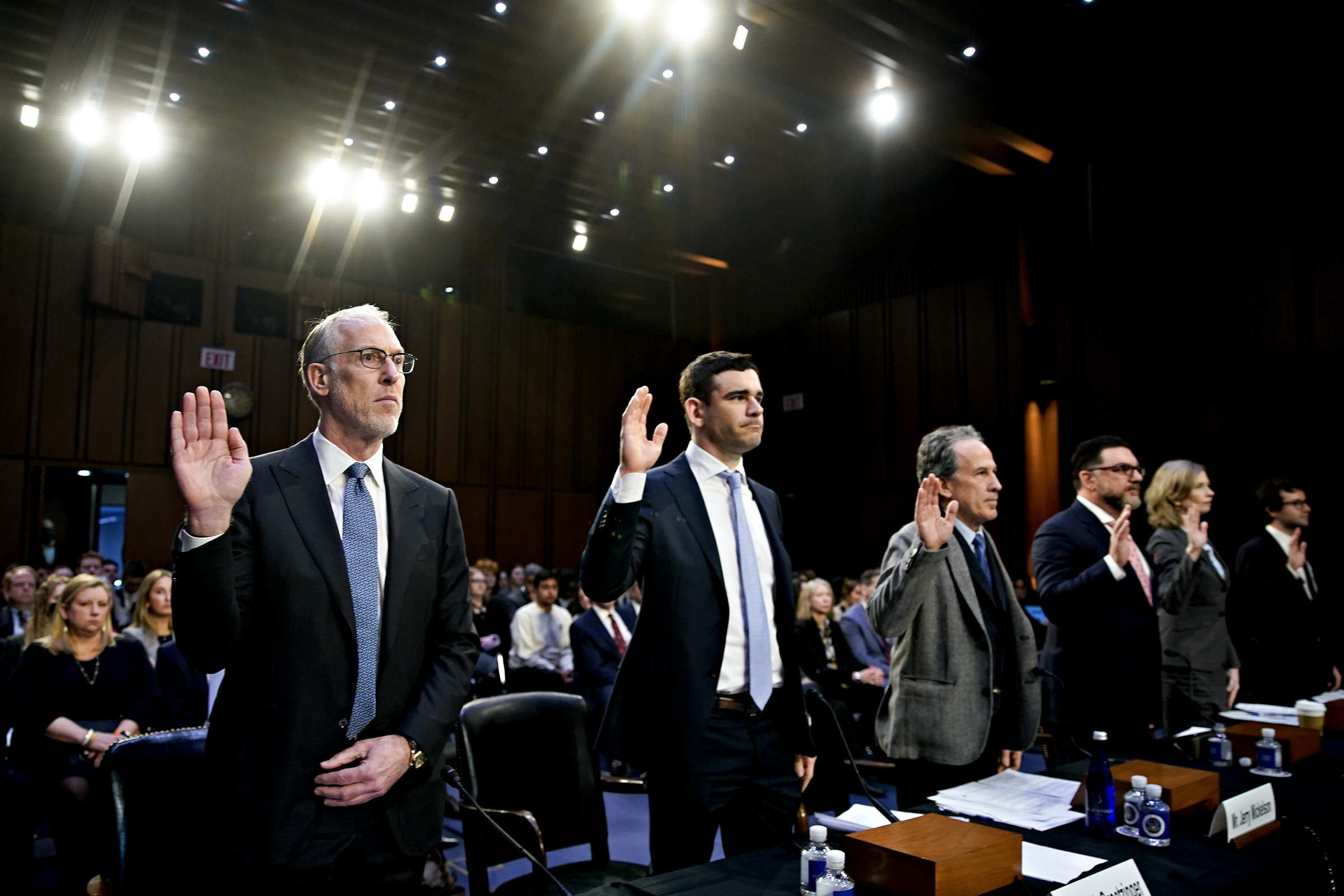
|
|
|
|
|
|
Ticketmaster and Live Nation executives testified at a Senate hearing after demand for tickets overwhelmed the siteAl Drago—Bloomberg/Getty Images
|
|
|
|
|
|
“I knew this tour was harder than anything I’d ever done before by a long shot,” Swift says. Each show spans over 180 minutes, including 40-plus songs from at least nine albums; there are 16 costume changes, pyrotechnics, an optical illusion in which she appears to dive into the stage and swim, and not one but two cottagecore worlds, which feature an abundance of moss.
|
|
|
|
|
|
In the past, Swift jokes, she toured “like a frat guy.” This time, she began training six months ahead of the first show. “Every day I would run on the treadmill, singing the entire set list out loud,” she said. “Fast for fast songs, and a jog or a fast walk for slow songs.” Her gym, Dogpound, created a program for her, incorporating strength, conditioning, and weights. “Then I had three months of dance training, because I wanted to get it in my bones,” she says. “I wanted to be so over-rehearsed that I could be silly with the fans, and not lose my train of thought.” She worked with choreographer Mandy Moore—recommended by her friend Emma Stone, who worked with Moore on *La La Land*—since, as Swift says, “Learning choreography is not my strong suit.” With the exception of Grammy night—which was “hilarious,” she says—she also stopped drinking. “Doing that show with a hangover,” she says ominously. “I don’t want to know that world.”
|
|
|
|
|
|
**Read More:** *[Taylor Swift Shares Her Eras Tour Workout and Self-Care Regimen](https://time.com/6343028/taylor-swift-workout-routine-eras-tour/)*
|
|
|
|
|
|
Swift’s arrival in a city energized the local economy. When Eras kicked off in Glendale, Ariz., she generated more revenue for its businesses than the 2023 Super Bowl, which was held in the same stadium. Fans flew across the country, stayed in hotels, ate meals out, and splurged on everything from sweatshirts to limited-edition vinyl, with the average Eras attendee reportedly spending nearly $1,300. Swift sees the expense and effort incurred by fans as something she needs to repay: “They had to work really hard to get the tickets,” she says. “I wanted to play a show that was longer than they ever thought it would be, because that makes me feel good leaving the stadium.” The “Taylor effect” was noticed at the highest levels of government. “When the Federal Reserve mentions you as the reason economic growth is up, that’s a big deal,” says Ed Tiryakian, a finance professor at Duke University.
|
|
|
|
|
|
Carrying an economy on your back is a lot for one person. After she plays a run of shows, Swift takes a day to rest and recover. “I do not leave my bed except to get food and take it back to my bed and eat it there,” she says. “It’s a dream scenario. I can barely speak because I’ve been singing for three shows straight. Every time I take a step my feet go *crunch, crunch, crunch* from dancing in heels.” Maintaining her strength through workouts between shows is key. “I know I’m going on that stage whether I’m sick, injured, heartbroken, uncomfortable, or stressed,” she says. “That’s part of my identity as a human being now. If someone buys a ticket to my show, I’m going to play it unless we have some sort of force majeure.” (A heat wave in Rio de Janeiro caused chaos during Swift’s November run as one fan, Ana Clara Benevides Machado, reportedly collapsed during the show and later died; Swift wrote on Instagram that she had a “shattered heart.” She rescheduled the next show because of unsafe conditions, and spent time with Benevides Machado’s family at her final tour date in Brazil.)
|
|
|
|
|
|
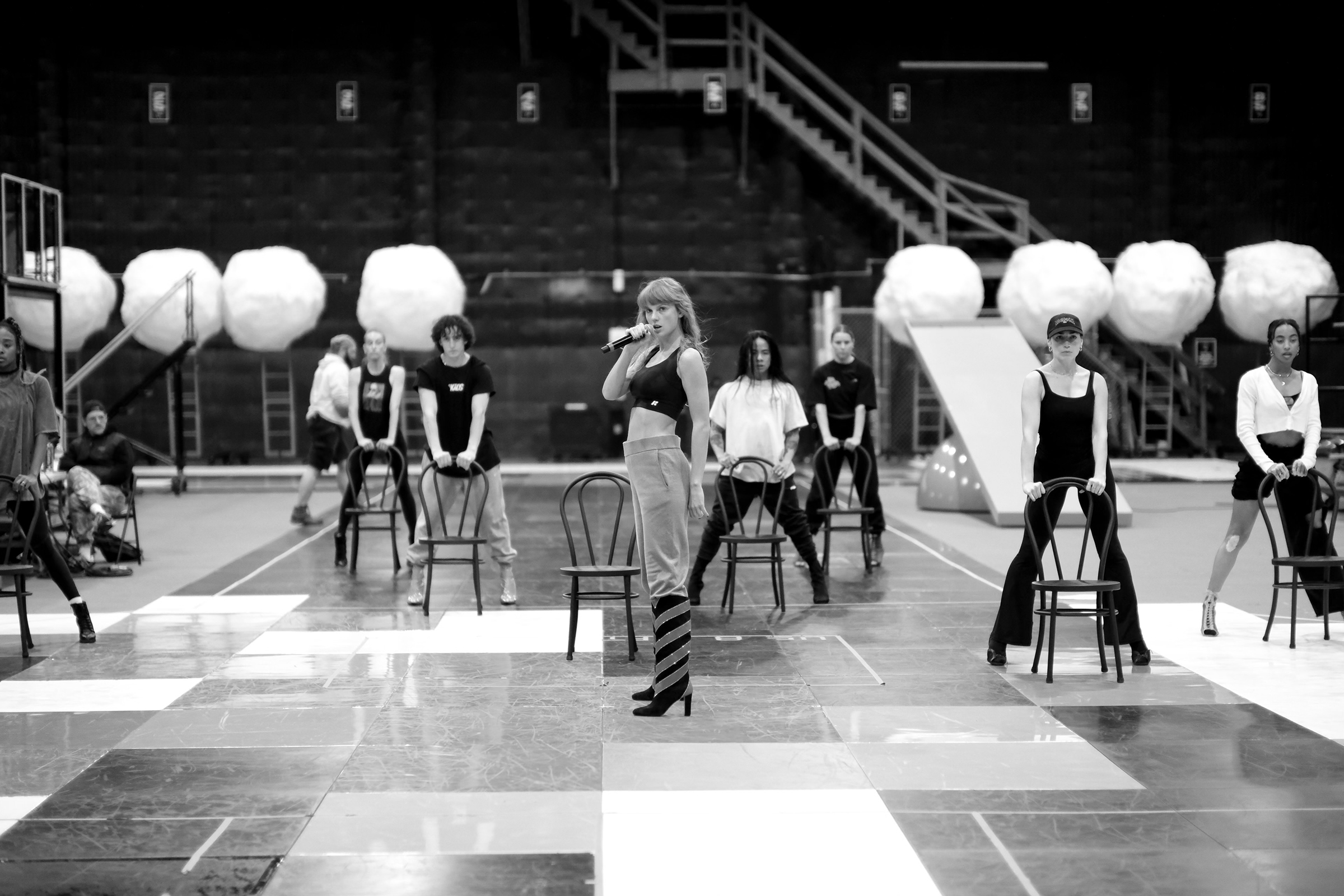
|
|
|
|
|
|
Swift told TIME she started training six months in advance of the Eras Tour, which kicked off in MarchCourtesy TAS Rights Management
|
|
|
|
|
|
Swift is many things onstage—vulnerable and triumphant, playful and sad—but the intimacy of her songcraft is front and center. “Her work as a songwriter is what speaks most clearly to me,” says filmmaker Greta Gerwig, whose feminist *Barbie* was its own testament to the idea that women can be anything. “To write music that is from the deepest part of herself and have it directly speak into the souls of other people.” As Swift whips through the eras, she’s not trying to update her old songs, whether the earnest romance of “You Belong With Me” or the millennial ennui of “22,” so much as she is embracing them anew. She’s modeling radical self-acceptance on the world’s largest stage, giving the audience a space to revisit their own joy or pain, once dismissed or forgotten. I tell Swift that the show made me think of a meme that says, “Do not kill the part of you that is cringe—kill the part of you that cringes.” “Yes!” she exclaims. “Every part of you that you’ve ever been, every phase you’ve ever gone through, was you working it out in that moment with the information you had available to you at the time. There’s a lot that I look back at like, ‘Wow, a couple years ago I might have cringed at this.’ You should celebrate who you are now, where you’re going, and where you’ve been.”
|
|
|
|
|
|
**Read More:** *[How We Chose Taylor Swift as TIME's 2023 Person of the Year](https://time.com/6342816/person-of-the-year-2023-taylor-swift-choice/)*
|
|
|
|
|
|
Getting to this place of harmony with her past took work; there’s a dramatic irony, she explains, to the success of the tour. “It’s not lost on me that the two great catalysts for this happening were two horrendous things that happened to me,” Swift says, and this is where the story takes a turn. “The first was getting canceled within an inch of my life and sanity,” she says plainly. “The second was having my life’s work taken away from me by someone who hates me.”
|
|
|
|
|
|
---
|
|
|
|
|
|
**Swift shows me** some things she loves in her apartment: a Stevie Nicks Barbie that sits still boxed in her kitchen, sent to her by the artist; the framed note from Paul McCartney that hangs in her bathroom; tiles around the fireplace that Swift found shopping in Paris with her mother. Connections to her family are everywhere, including a striking photo of her grandmother Marjorie, an opera singer and the inspiration for a track on her album *evermore.* Swift grew up on a Christmas-tree farm in Pennsylvania, with her younger brother Austin; her father Scott was a stockbroker at Merrill Lynch, and Andrea worked in marketing. Her family still works closely with her today. “My dad, my mom, and my brother come up with some of the best ideas in my career,” Swift says. “I always joke that we’re a small family business.”
|
|
|
|
|
|
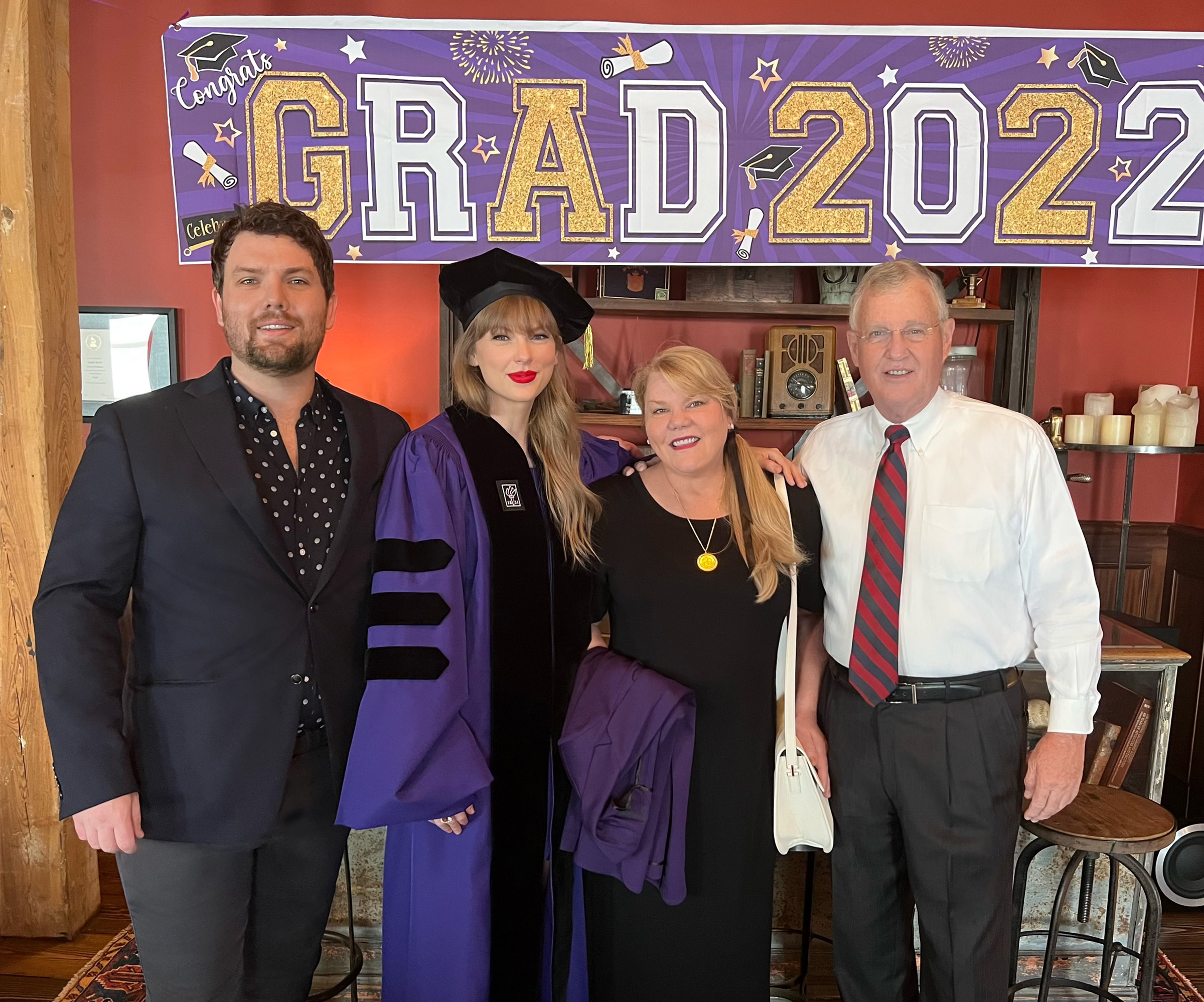
|
|
|
|
|
|
Austin, Andrea, and Scott Swift with Taylor at NYU graduation in 2022 where she received an honorary Doctorate of Fine ArtsCourtesy TAS Rights Management
|
|
|
|
|
|
After moving to Nashville as a teen, she signed with Scott Borchetta’s Big Machine Records. Swift’s songwriting ability was evident from the first lyrics of “Tim McGraw,” her debut single: “He said the way my blue eyes shined put those Georgia stars to shame that night—I said, ‘That’s a lie.’” Even for country music these lyrics are literary—conjuring a romantic fantasy, then deflating it a line later. The fairy-tale promise of love and intimacy became a runner in Swift’s work as a songwriter, something she’d repeatedly espouse, then skewer; she was self-aware about the role narrative played in her expectations. She was seen as a gifted pop-country ingenue when, in a now infamous moment, Kanye West interrupted Swift onstage at the 2009 VMAs while she was accepting an award. The incident set in motion a chain of events that would shape the next decade of both artists’ lives.
|
|
|
|
|
|
It was around that time, Swift remembers now, that she began trying to shape-shift. “I realized every record label was actively working to try to replace me,” she says. “I thought instead, I’d replace myself first with a new me. It’s harder to hit a moving target.” Swift wrote songs solo, incorporated diverse sonic influences, and placed more clues about personal relationships in her lyrics and album materials for fans to decode. Her epic ballad “All Too Well,” from 2012’s *Red,* epitomizes Swift’s superpower as a songwriter, deploying tossed-off details like a forgotten scarf that comes back at the song’s end to stab you in the heart—but it also had a secret message hidden in the liner notes. When an extended version of the song hit No. 1 last year upon its rerelease, it wasn’t only because the song is extraordinary, but because it has its own lore, like Carly Simon’s “You’re So Vain” if it came with an experiential puzzle for fans to solve. “She’s like a whole room of writers as one person, with that voice and charisma,” Bridgers says. “She’s everything at once.”
|
|
|
|
|
|
[](https://timecoverstore.com/collections/2023+person+of+the+year)[*Buy a print of the Person of the Year covers now*](https://timecoverstore.com/collections/2023+person+of+the+year)
|
|
|
|
|
|
Swift knew she had to keep innovating. “By the time an artist is mature enough to psychologically deal with the job, they throw you out at 29, typically,” she says. “In the ’90s and ’00s, it seems like the music industry just said: ‘OK, let’s take a bunch of teenagers, throw them into a fire, and watch what happens. By the time they’ve accumulated enough wisdom to do their job effectively, we’ll find new teenagers.’” She went [full-throttle pop for 2014’s *1989*](https://time.com/6328790/taylor-swift-1989-2/)*,* putting her [on top of the world](https://time.com/3583129/power-of-taylor-swift-cover/)—“an imperial phase,” she calls it. She didn’t realize it would also give her much farther to fall. Public sentiment turned—sniping about everything from her perceived overexposure to conspiracy theories about her politics. “I had all the hyenas climb on and take their shots,” she says. West wrote a song with vulgar lyrics about her, and claimed that Swift had consented to it, which Swift denied; West’s then wife, Kim Kardashian, released a video of a conversation between West and Swift that seemed to indicate that Swift had been on board with the song. The scandal was tabloid catnip; it made Swift look like a snake, which is what people called her. She felt it was “a career death,” she says. “Make no mistake—my career was taken away from me.”
|
|
|
|
|
|

|
|
|
|
|
|
Inez and Vinoodh for TIME
|
|
|
|
|
|
It was a bleak moment. “You have a fully manufactured frame job, in an illegally recorded phone call, which Kim Kardashian edited and then put out to say to everyone that I was a liar,” she says. “That took me down psychologically to a place I’ve never been before. I moved to a foreign country. I didn’t leave a rental house for a year. I was afraid to get on phone calls. I pushed away most people in my life because I didn’t trust anyone anymore. I went down really, really hard.” (Kardashian wrote, in a 2020 social media post, that the situation “forced me to defend him.”) Swift’s next album, 2017’s *Reputation,* featured snake imagery; the video for “Look What You Made Me Do” saw her killing off younger versions of herself. She remembers *Reputation* being met with uproar and skepticism. “I thought that moment of backlash was going to define me negatively for the rest of my life,” she says. She had also satisfied her record deal with Borchetta, and knew she wanted out. “The molecular chemistry of that old label was that every creative choice I wanted to make was second-guessed,” she says. “I was really overthinking these albums.”
|
|
|
|
|
|
She met with Lucian Grainge, the CEO of Universal Music Group, and Monte Lipman, who runs Universal’s top label Republic Records, to talk about signing a deal that would give her more agency. Today, Grainge is perhaps the most powerful executive in the music industry, but, as I sit with him in his office in Los Angeles, he describes himself as an “old punk” who operates on instinct more than metrics. He told Swift, he says, “We will utilize everything that we’ve got as a company for you.” Swift felt like she’d been given carte blanche: “Lucian and Monte basically said to me, ‘Whatever you turn in, we will be proud to put out. We give you 100% creative freedom and trust.’” It was exactly what she needed to hear most when the chips were down.
|
|
|
|
|
|
Yet the release of Swift’s first album with Republic, 2019’s *[Lover](https://time.com/5651207/taylor-swift-lover-songs-explained/),* coincided with the second big upheaval in her professional life: Borchetta had sold Big Machine—and with it, Swift’s catalog, valued then at a reported $140 million—to Ithaca Holdings, which is owned by music manager Scooter Braun, a former ally of West’s. “With the Scooter thing, my masters were being sold to someone who actively wanted them for nefarious reasons, in my opinion,” Swift says. (“It makes me sad that Taylor had that reaction to the deal,” Braun told *Variety* in 2021.) The sale meant that the [rights to Swift’s first six albums](https://time.com/5618336/taylor-swift-scooter-braun-masters/) moved to Braun, so whenever someone wanted to license one of those songs, he would be the one to profit. Swift rallied her fans against the deal, but still felt powerless. “I was so knocked on my ass by the sale of my music, and to whom it was sold,” she says. “I was like, ‘Oh, they got me beat now. This is it. I don’t know what to do.’” She went back to work, using the pandemic lockdown to pare back her sound on critically acclaimed albums *[folklore](https://time.com/5871159/taylor-swift-folklore-explained/)* and *[evermore](https://time.com/5920105/taylor-swift-evermore/).*
|
|
|
|
|
|
Around the same time, she started thinking about rerecording her old albums in an effort to wrest back control. “I’d run into Kelly Clarkson and she would go, ‘Just redo it,’” Swift says. “My dad kept saying it to me too. I’d look at them and go, ‘How can I possibly do that?’ Nobody wants to redo their homework if on the way to school, the wind blows your book report away.” Since Swift wrote her own songs, she retained the musical composition copyright and could rerecord them. She also negotiated to own the master rights for her material when she moved over to Republic in 2018, so she now owns her new material and the rerecorded songs. (Major labels have since made it more difficult for artists to rerecord their music.) She began rerecording subtly different versions of her old albums, tagging them “(Taylor’s Version)” and adding unreleased tracks to redirect listenership to them. She frames the strategy as a coping mechanism. “It’s all in how you deal with loss,” she says. “I respond to extreme pain with defiance.”
|
|
|
|
|
|
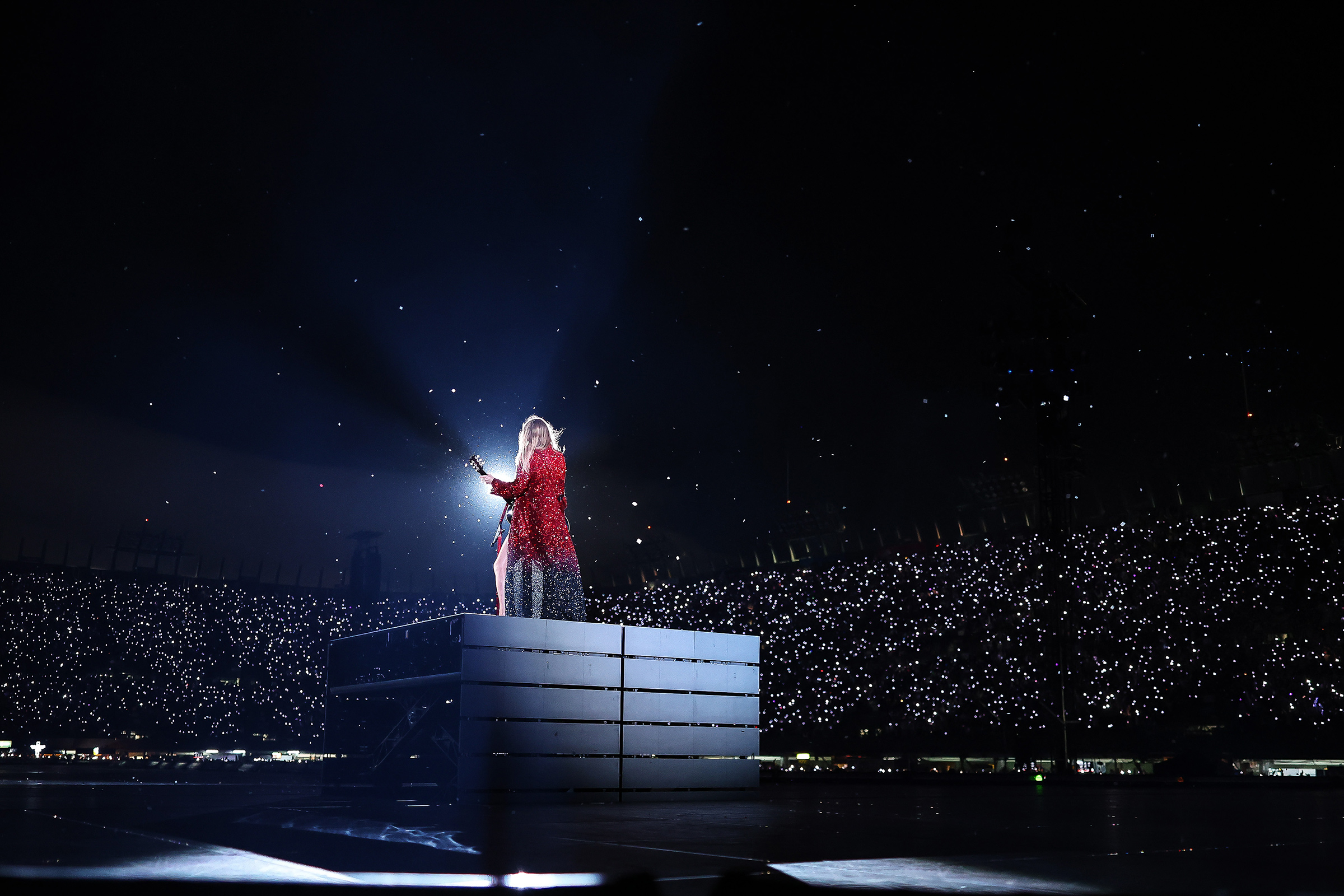
|
|
|
|
|
|
Swift performs at Foro Sol in Mexico City on Aug. 24Hector Vivas—TAS23/Getty Images for TAS Rights Management
|
|
|
|
|
|
Grainge calls the rerecording project “bizarrely brilliant and unique”—something that only an artist at her level could pull off. “It’s got such a narrative—there’s a reason for it.” He shakes his head. “Imagine Picasso painting something that he painted a few years ago, then re-creating it with the colors of today.” Part of the success story, Swift says, is the freedom she received from the label to follow her instincts. “If you look at what I’ve put out since then, it’s more albums in the last few years than I did in the first 15 years of my career,” she says. That prolific output has fueled her ascension. “She could serve two terms as President of the United States and then go to Las Vegas,” Grainge says. “Who else can do that?”
|
|
|
|
|
|
In the grand narrative of Swift’s life, as she rose this year, her foes’ fortunes also seemed to turn. Over the summer, it was reported that several of Braun’s key clients—chief among them Justin Bieber and Ariana Grande—were no longer being managed by his company, while West’s antisemitic and other offensive remarks led to his losing key endorsement deals. Swift knows firsthand that fame is a seesaw. “Nothing is permanent,” she says. “So I’m very careful to be grateful every second that I get to be doing this at this level, because I’ve had it taken away from me before. There is one thing I’ve learned: My response to anything that happens, good or bad, is to keep making things. Keep making art.” She considers. “But I’ve also learned there’s no point in actively trying to quote unquote defeat your enemies,” she says. “Trash takes itself out every single time.”
|
|
|
|
|
|
---
|
|
|
|
|
|
**The premiere for** Swift’s concert film takes place at the Grove, an outdoor mall in Los Angeles, which has been shut down for the event; Swift has packed 13 screens with thousands of fans. She goes, one by one, to each theater thanking sobbing audience members for being there. Like the tour, the film, which was released directly to theaters without a traditional partner, is an event. “We met with all the studios,” she tells me, “and we met with all the streamers, and we sized up how it was perceived and valued, and if they had high hopes and dreams for it. Ultimately I did what I tend to do more and more often these days, which is to bet on myself.” She credits her father with the idea. “He just said, why does there have to be a—for lack of a better word—middleman?”
|
|
|
|
|
|
**Read More:** *['I Bet on Myself.' How Taylor Swift's Deal With AMC Came Together](https://time.com/6342992/taylor-swift-amc-eras-tour-movie-deal/)*
|
|
|
|
|
|
In the theater excitement ripples through the crowd, a mix of fans and Swift’s friends, as we wait for her. To my left are two dedicated Swifties, sisters who introduce themselves as Madison, 23, and McCall, 20, and who are still reeling from taking a selfie with Swift on the red carpet. Their wrists are covered in friendship bracelets, some of which are deep cuts—such as no it’s BECKY, a reference to a beloved Tumblr meme, and BLEACHELLA STAN, for Swift’s 2016 platinum blond bob—and Madison reveals a tattoo on her forearm that says “Taylor’s Version.” Both tell me their favorite album is *Reputation.* They are my favorite people I have ever met, and I want to talk to only them for the rest of my life. Madison admires Swift for her vulnerability—“which is insane, when she’s under endless scrutiny”—while McCall cites her consistency, which she calls “a lost art form.” When I ask how McCall feels about Swift’s romantic life, she fields the question elegantly. “It’s a disservice to her to focus on that stuff,” she says. “She’s so good at making her personal experience relate to millions of people. When I listen to her songs, I think about what I’ve been through—not what she’s been through.”
|
|
|
|
|
|
Swift’s private life has long served as both grist for the tabloid mill and inspiration for her own work; she split from her longtime boyfriend, actor Joe Alwyn, earlier this year. Most recently, she’s been dating the [NFL star Travis Kelce](https://time.com/6317898/travis-kelce-taylor-swift-relationship/), as has been well documented when she attends his games. “I don’t know how they know what suite I’m in,” she says. “There’s a camera, like, a half-mile away, and you don’t know where it is, and you have no idea when the camera is putting you in the broadcast, so I don’t know if I’m being shown 17 times or once.” She is sensitive to the attention that’s put on her when she shows up. “I’m just there to support Travis,” she says. “I have no awareness of if I’m being shown too much and pissing off a few dads, Brads, and Chads.”
|
|
|
|
|
|
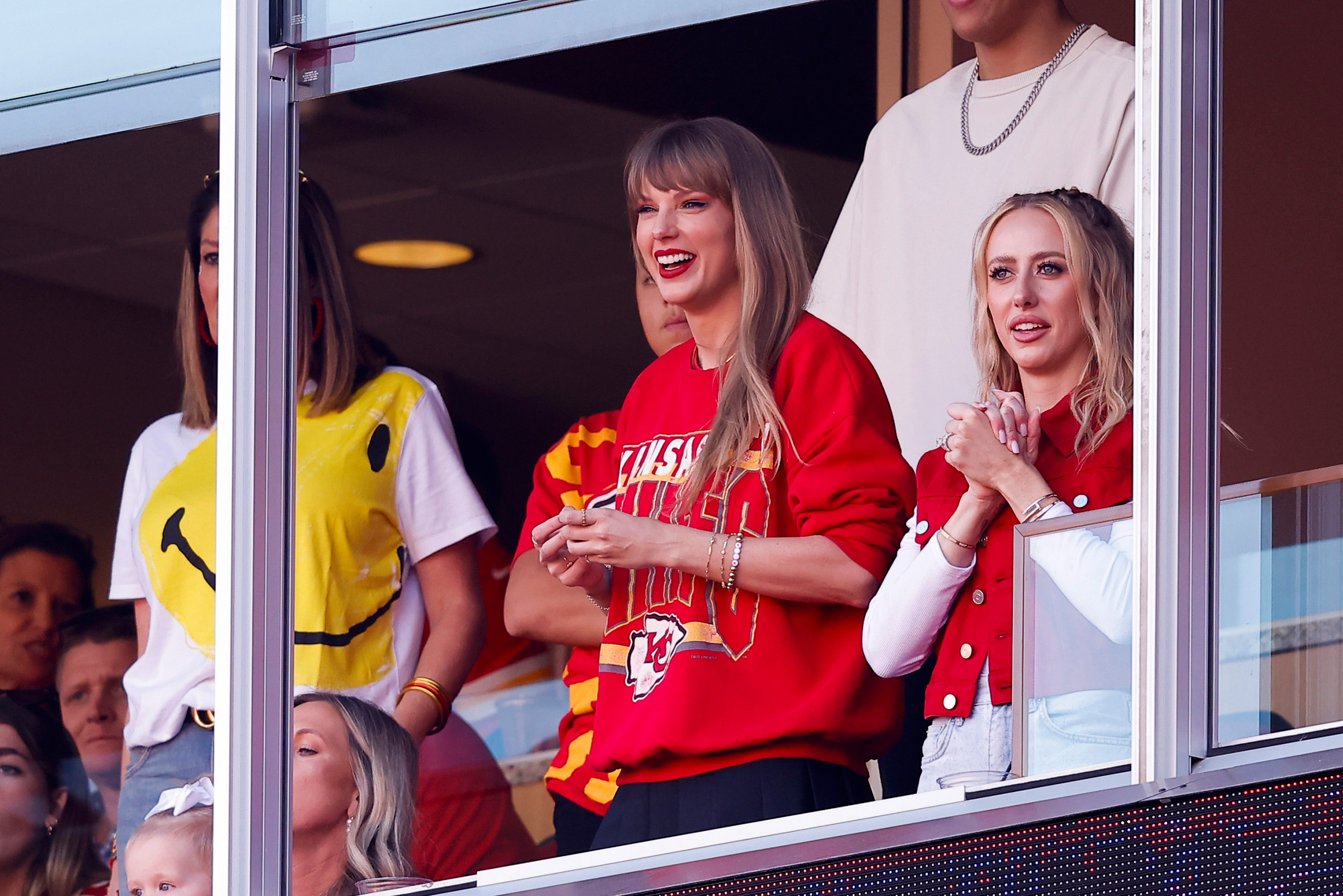
|
|
|
|
|
|
After playing Kansas City in July, Swift returned in October to support her boyfriend, Chiefs star Travis KelceDavid Eulitt—Getty Images
|
|
|
|
|
|
I point out that it’s a net positive for the NFL to have a few Swifties watching. “Football is awesome, it turns out,” Swift says playfully. “I’ve been missing out my whole life.” (A [game she attended in October](https://time.com/6319422/taylor-swift-travis-kelce-nfl-tv/) was the most-watched Sunday show since the Super Bowl.)
|
|
|
|
|
|
Given her complex history with public interest in her dating life, I say, it seems noteworthy that her relationship with Kelce has played out so publicly. Swift gently pushes back: “This all started when Travis very adorably put me on blast on his podcast, which I thought was metal as hell,” she says. “We started hanging out right after that. So we actually had a significant amount of time that no one knew, which I’m grateful for, because we got to get to know each other. By the time I went to that first game, we were a couple. I think some people think that they saw our first date at that game? We would never be psychotic enough to hard launch a first date.” The larger point, for her, is that there’s nothing to hide. “When you say a relationship is public, that means I’m going to see him do what he loves, we’re showing up for each other, other people are there and we don’t care,” she says. “The opposite of that is you have to go to an extreme amount of effort to make sure no one knows that you’re seeing someone. And we’re just proud of each other.”
|
|
|
|
|
|
Swift’s openness is one part of why her fan base leans heavily, though not exclusively, female. The Eras Tour was one critical piece of what Swift calls “a three-part summer of feminine extravaganza”—the other two parts being Gerwig’s box-office bonanza *Barbie* and Beyoncé’s blockbuster, culture-shifting Renaissance Tour. “To make a fun, entertaining blast of a movie, with that commentary,” she says of *Barbie,* “I cannot imagine how hard that was, and Greta made it look so easy.” (“I’m just a sucker for a gal who is good with words, and she is the best with them,” Gerwig says about Swift, whom she calls “Bruce Springsteen meets Loretta Lynn meets Bob Dylan.”)
|
|
|
|
|
|
Swift is no less effusive in talking about Beyoncé, who brokered a similar deal with AMC and shows up to Swift’s Los Angeles premiere; the next month, Swift returns the favor by attending Beyoncé’s in London. “She’s the most precious gem of a person—warm and open and funny,” Swift says. “And she’s such a great disrupter of music-industry norms. She taught every artist how to flip the table and challenge archaic business practices.” That her tour and Beyoncé’s were frequently juxtaposed is vexing. “There were so many stadium tours this summer, but the only ones that were compared were me and Beyoncé,” she says. “Clearly it’s very lucrative for the media and stan culture to pit two women against each other, even when those two artists in question refuse to participate in that discussion.”
|
|
|
|
|
|
**Read More:** *[‘The Most Precious Gem of a Person:’ Taylor Swift on Her Friendship With Beyoncé](https://time.com/6343062/taylor-swift-beyonce-friendship-renaissance/)*
|
|
|
|
|
|
To Swift, the success of all three feels like an inflection point. “If we have to speak stereotypically about the feminine and the masculine,” she says, “women have been fed the message that what we naturally gravitate toward—” She has a few examples: “Girlhood, feelings, love, breakups, analyzing those feelings, talking about them nonstop, glitter, sequins! We’ve been taught that those things are more frivolous than the things that stereotypically gendered men gravitate toward, right?” Right, I say. “And what has existed since the dawn of time? A patriarchal society. What fuels a patriarchal society? Money, flow of revenue, the economy. So actually, if we’re going to look at this in the most cynical way possible, feminine ideas becoming lucrative means that more female art will get made. It’s extremely heartening.”
|
|
|
|
|
|
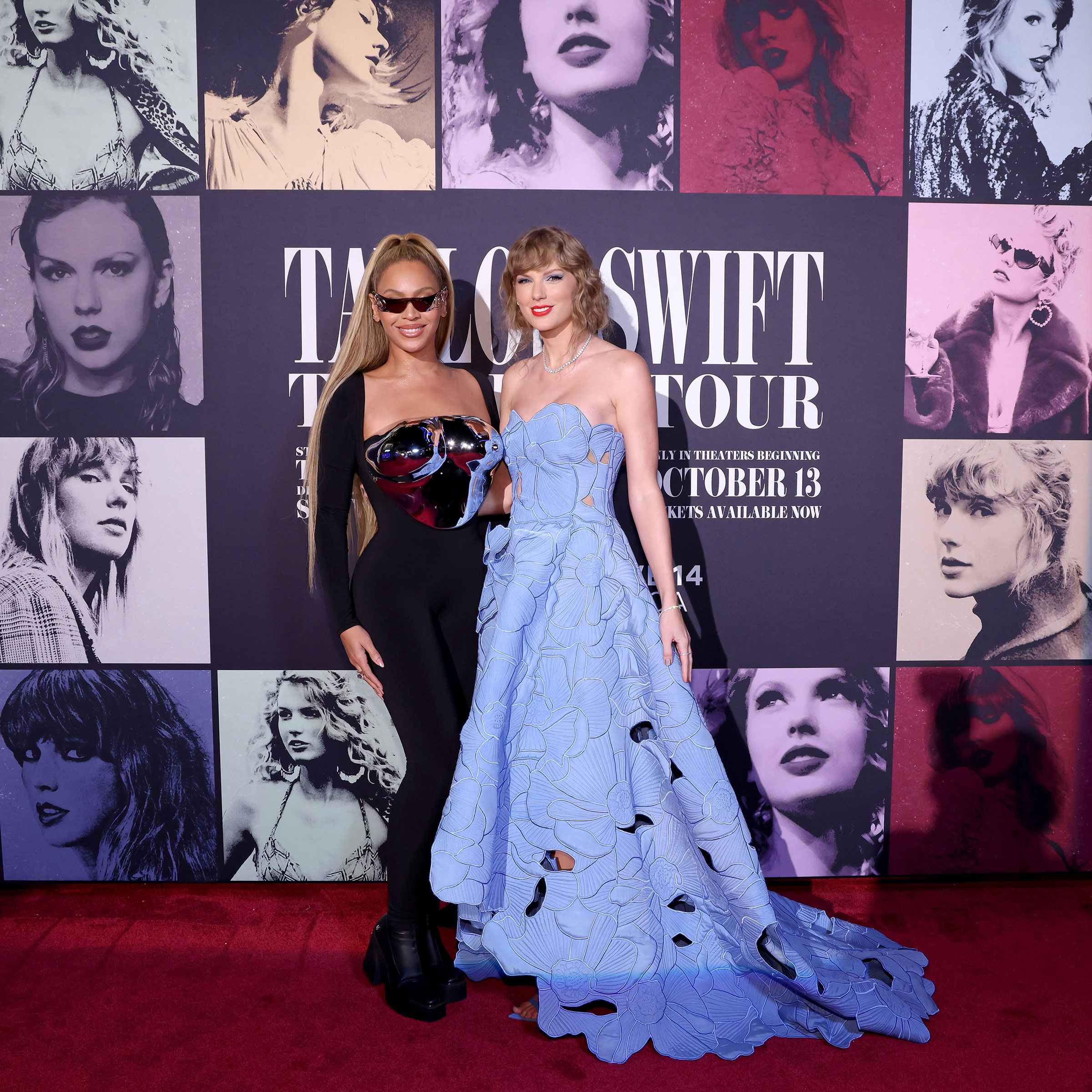
|
|
|
|
|
|
Beyoncé joined Swift in Los Angeles on Oct. 11 for the first screening of her Eras Tour filmJohn Shearer—Getty Images for TAS
|
|
|
|
|
|
Amid so much attention, it seems noteworthy that Swift appears more relaxed in the public eye, not less—although I wonder out loud whether it just appears that way. She nods. “Over the years, I’ve learned I don’t have the time or bandwidth to get pressed about things that don’t matter. Yes, if I go out to dinner, there’s going to be a whole chaotic situation outside the restaurant. But I still want to go to dinner with my friends.” She sounds thoughtful. “Life is short. Have adventures. Me locking myself away in my house for a lot of years—I’ll never get that time back. I’m more trusting now than I was six years ago.”
|
|
|
|
|
|
She’s also having more fun. At her premiere, Swift sits in the same row as me, Madison, and McCall, singing along and dancing in her seat; we keep craning our necks to look at her, sharing thunderstruck looks: *Isn’t this surreal?* There are moments in the film when the cameras capture the enormous screens behind Swift onstage, and it feels like a house of mirrors, these myriad reflections of Taylor Swift—us watching her watch herself on a screen, which is itself showing Swift’s image on so many screens, the thousands of fans onscreen in the stadium and us in this theater, with Swift in the middle of it—all of us rapt, unable to look away.
|
|
|
|
|
|
**Read More:** *[Taylor Swift Makes History as Person of the Year. Here’s How](https://time.com/6343069/taylor-swift-history-person-of-the-year/)*
|
|
|
|
|
|
---
|
|
|
|
|
|
**Swift and I have been talking** for a while now at her apartment, long enough that our coffees have gone cold and her cat Benjamin Button has trundled into the room, then gotten bored and left. She tells me about revisiting *Reputation,* which is perhaps the most charged era in the tour. “It’s a goth-punk moment of female rage at being gaslit by an entire social structure,” she says, laughing. “I think a lot of people see it and they’re just like, Sick snakes and strobe lights.” The upcoming vault tracks for *Reputation* will be “fire,” she promises. The rerecordings project feels like a mythical quest to her. “I’m collecting horcruxes,” she says. “I’m collecting infinity stones. Gandalf’s voice is in my head every time I put out a new one. For me, it is a movie now.”
|
|
|
|
|
|
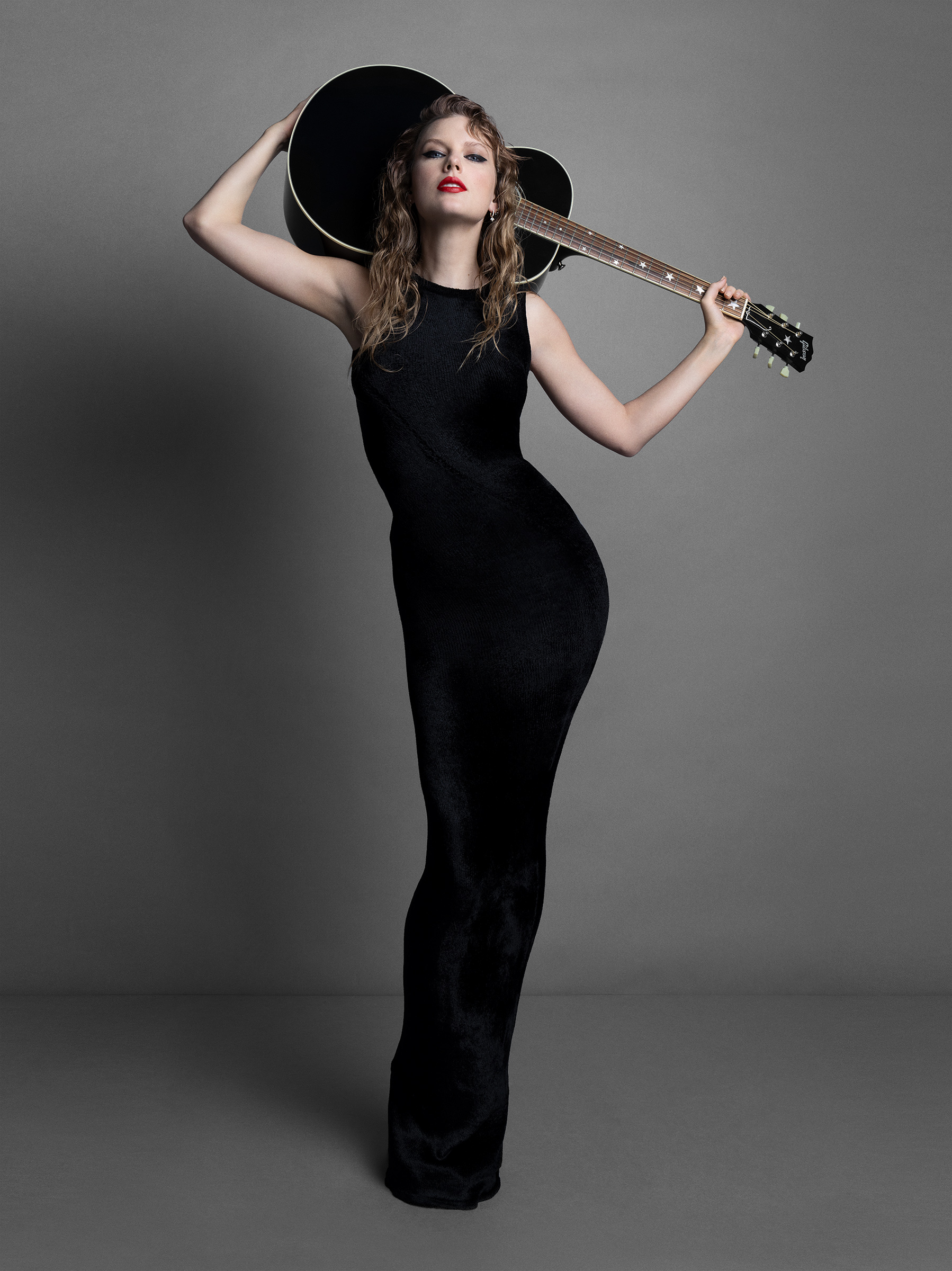
|
|
|
|
|
|
Inez and Vinoodh for TIME
|
|
|
|
|
|
It strikes me then that for all the talk about eras, it’s also worth thinking about genres—how Swift has moved between them in the stories she’s told. At first, it was a coming-of-age story, one about a young woman finding her way in the world and honing her voice before a fickle public. Then there were romances, great ones—tales of enchantment and desire, heartbreak and disillusionment, relationships that she both excavated for her songs and that the media documented for her with either joy or schadenfreude, depending on the day. There have been dramas with stakes so high and turns so twisty they feel Shakespearean in their scope, betrayals both personal and professional that have shaped her life. Occasionally, these stories have tipped into screwball comedy—like when a crowd in Seattle cheered so loudly it registered as an earthquake, or when, on a tour stop in Brazil, the local archdiocese allowed messages celebrating her to be projected onto the 124-ft. Christ the Redeemer statue. But they have one thing in common: Swift.
|
|
|
|
|
|
She is a maestro of self-determination, of writing her own story. The multihyphenate television creator Shonda Rhimes—no stranger to a plot twist—who has known Swift since she was a teenager, puts it simply: “She controls narrative not only in her work, but in her life,” she says. “It used to feel like people were taking shots at her. Now it feels like she’s providing the narrative—so there aren’t any shots to be taken.”
|
|
|
|
|
|
**Read More:** *[Behind the Scenes of TIME’s 2023 Person of the Year Issue](https://time.com/6342829/person-of-the-year-2023-editors-letter/)*
|
|
|
|
|
|
Here, Swift has told me a story about redemption, about rising and falling only to rise again—a hero’s journey. I do not say to her, in our conversation, that it did not always look that way from the outside—that, for example, when *Reputation*’s lead single “Look What You Made Me Do” reached No. 1 on the charts, or when the album sold 1.3 million albums in the first week, second only to *1989,* she did not look like someone whose career had died. She looked like a superstar who was mining her personal experience as successfully as ever. I am tempted to say this.
|
|
|
|
|
|
But then I think, Who am I to challenge it, if that’s how she felt? The point is: she *felt* canceled. She *felt* as if her career had been taken from her. Something in her had been lost, and she was grieving it. Maybe this is the real Taylor Swift effect: That she gives people, many of them women, particularly girls, who have been conditioned to accept dismissal, gaslighting, and mistreatment from a society that treats their emotions as inconsequential, permission to believe that their interior lives matter. That for your heart to break, whether it’s from being kicked off a tour or by the memory of a scarf still sitting in a drawer somewhere or because somebody else controls your life’s work, is a valid wound, and no, you’re not crazy for being upset about it, or for wanting your story to be told.
|
|
|
|
|
|
After all, not to be corny, haven’t we all become selective autobiographers in the digital age as we curate our lives for our own audiences of any size—cutting away from the raw fabric of our lived experience to reveal the shape of the story we most want to tell, whether it’s on our own feeds or the world’s stage? I can’t blame her for being better at it than everyone else. It’s also not like she hasn’t admitted it. She sang it herself, in her song “Mastermind,” off last year’s *[Midnights](https://time.com/6223793/taylor-swift-midnights-album-takeaways/),* in a bridge so feathery you could almost miss that it marks some of the rawest, most naked songwriting of her career: “No one wanted to play with me as a little kid/ So I’ve been scheming like a criminal ever since/ To make them love me and make it seem effortless/ This is the first time I’ve felt the need to confess/ And I swear I’m only cryptic and Machiavellian because I care.”
|
|
|
|
|
|

|
|
|
|
|
|
Inez and Vinoodh for TIME
|
|
|
|
|
|
She tells me she wrote that song after watching the Paul Thomas Anderson film *Phantom Thread,* which—spoiler—culminates in the reveal of a vast, layered manipulation. “Remember that last scene?” she says. “I thought, wouldn’t it be fun to have a lyric about being calculated?” She pauses. “It’s something that’s been thrown at me like a dagger, but now I take it as a compliment.”
|
|
|
|
|
|
It *is* a compliment. After I leave Swift’s house, I can’t stop thinking about how perfectly she crafted this story for me—the one about redemption, how she lost it all and got it back. Storytelling is what she’s always done; that’s why, Chesney tells me, he gave her that gift all those years ago. “She was a writer who had something to say,” he says. “That isn’t something you can fake by writing clichés. You can only live it, then write it as real as possible.”
|
|
|
|
|
|
She must have known that all the references she made had hidden meanings, that I’d see all the tossed-off details for the Easter eggs they were. The way she told me that story about Chesney, she knew there was a lesson, about the power of generosity, and how a crushing defeat can give way to a great and surprising gift. The way she said, “Are you not entertained?”—surely we both knew it was a quote from *Gladiator,* a movie in which a hero falls from grace, is forced to perform blood sport for the pleasure of spectators, and emerges victorious, having survived humiliation and debasement to soar higher than ever. And the way before I left, she showed me the note from Paul McCartney hanging in her bathroom, which has a Beatles lyric written on it—and not just any Beatles lyric, but this one: “Take these broken wings and learn to fly.” —*With reporting by* Leslie Dickstein *and* Megan McCluskey •
|
|
|
|
|
|
Styled by Heidi Bivens at Honey Artists; hair by Holli Smith; make-up by Diane Kendal; nails by Maki Sakamoto; production by VLM Productions
|
|
|
|
|
|
On the covers:
|
|
|
|
|
|
*Jacket, denim shirt and turtleneck by Polo Ralph Lauren; dress by Area; bodysuit by Bardot, tights by Wolford; earrings are artist’s own*
|
|
|
|
|
|
On the inside:
|
|
|
|
|
|
*Jacket, denim shirt and turtleneck by Polo Ralph Lauren; tuxedo jacket, tuxedo shirt, vest and pocket square by Ralph Lauren Collection, jeans by Polo Ralph Lauren; dress by Alaia; rings by Anna Sheffield and Cartier; earrings are artist’s own*
|
|
|
|
|
|
 
|
|
|
 
|
|
|
|
|
|
---
|
|
|
`$= dv.el('center', 'Source: ' + dv.current().Link + ', ' + dv.current().Date.toLocaleString("fr-FR"))` |